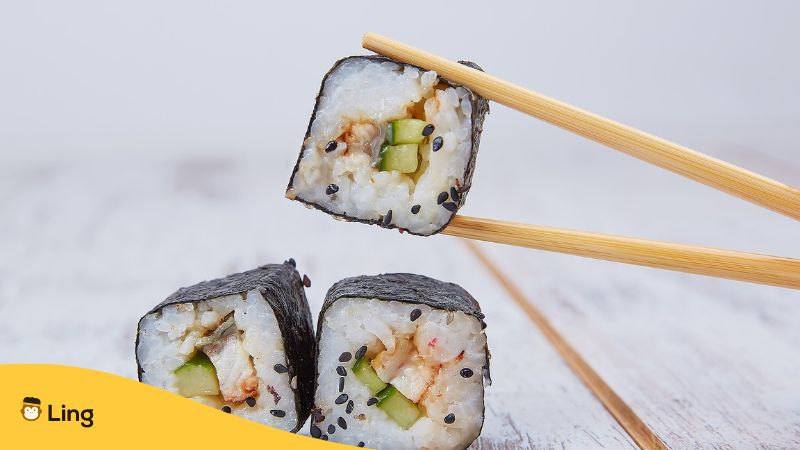Japan is famous for its delicious food, awesome sights, and polite Japanese manners and etiquette! Japanese people place a lot of emphasis on kindness, and their culture has been passing along the ways of gracious hospitality and mindfulness for centuries. For Japanese people, this is simply a way of life.
Whether you’re planning on visiting Japan and want to learn more about Japanese customs before you get there or just want to keep some nifty Japanese etiquette tips and tricks for table manners in your back pocket, keep reading! After all, even non-Japanese people should read up on these practices because having good manners and showing respect is always a good idea.
Table Of Contents
The Basics Of Japanese Manners And Etiquette
Japanese people are known to be very polite, and it is essential to show respect to others. Being disrespectful in Japanese culture can have negative consequences and make it difficult to establish trust and credibility. Now, let’s take a look at the basic elements of Japanese manners.
1. Greeting And Bowing
The Japanese bow, also known as ojigi! Perhaps the most famous of Japanese etiquette practices. This greeting is a must-know and important to remember when you’re in Japan. Since Japanese people are less likely to engage in body contact, greeting is a perfect way to respect personal space and still communicate a friendly hello!
When walking through the streets of Japan, you’ll probably see people spontaneously nod and bow to each other as they pass by or make eye contact. There are certain rules regarding when it is absolutely necessary to bow and when it’s not, but as a non-Japanese person, just giving a courteous bow when you greet someone or as you enter or leave an establishment is a great habit to practice.
2. At The Dinner Table
General dining etiquette in Japan suggests keeping a few things in mind when eating a meal. Here are just a few of them:
Remember to thank the host for being served and thank them again after finishing up. (More on that later!) Another thing is that it is usually not acceptable to ask to take your leftover food to go. When out with groups, it is rude to start eating by yourself, so it is polite to wait until everyone has something in front of them to dig in! And finally, when dining with communal dishes, if there is one last bite left, then it is good manners to ask if you can have the last bite.

3. A Note On Chopsticks
It is super important to remember to use your chopsticks properly. Don’t play around with them, and never stick them upright in a bowl of rice! Why? Chopsticks in a rice bowl are affiliated with Japanese funerals, and they are considered bad manners and are thought to bring bad luck.
Also, never pass food from chopsticks to chopsticks or use someone else’s chopsticks! This is considered rude.
4. Itadakimasu (いただきます) And Gochisousama (ごちそうさまでした)
What do you say if you’re in Japan and served food or a drink? Itadakimasu and gochisousama-deshita, of course! Let’s break these two phrases down.
If you’ve watched anime, you’ve probably seen the characters clap their hands right after a steaming bowl of something yummy gets served to them, and they utter an enthusiastic “Itadakimasu!” (いただきます). This means “I humbly receive” or “let’s eat” and is a classic practice of Japanese manners and etiquette. It’s all about thanking the host for serving you!
When you finish a meal, of course, you have to thank the host again for a generous space to eat and for the meal itself. This is when you say “Gochisousama-deshita!” (ごちそうさまでした) or “Thank you for everything!” which perfectly sums up anyone’s satiated sentiments.
5. Sushi
When in Japan, grabbing some sushi in the birthplace of this delicious delicacy is a must! There are two ways of eating sushi in Japan: with chopsticks or with your hands. There are no set-in-stone rules that span across all sushi types, but rather, there are methods that get used depending on the situation. Let’s get into it!
If you like to dip your sushi in soy sauce (like me—guilty!), then you should know that generally, only the fish side gets a bath in the soy sauce, not the rice! Additionally, wasabi should never be mixed with soy sauce.
6. Riding On Public Transportation
When riding on public transportation, it is considered good manners to speak quietly, line up on the side of the train car to let passengers get off before boarding and allow pregnant, elderly, or disabled riders to sit down.
It is frowned upon to talk on the phone at full volume, especially loudly. Please remember to keep your phone on silent mode and avoid making a call, as this could disturb your fellow passengers.

7. Taking Off Shoes Inside
The idea of taking your shoes off before you enter somewhere is a tradition that comes from the Japanese history of sitting or sleeping on tatami flooring. The protocol is as follows: you take off your shoes, leave them by the entrance at the designated shoe area, and then slip into indoor-use-only slippers.
When inside, it’s customary to remove your slippers when walking on tatami mats or when you pop in to use the bathroom. The latter will have a designated pair of toilet slippers for you. Because of the no-shoe rule, most places will have slippers available for you to use for those occasions when you have to step indoors.
8. At The Onsen And Bathing Etiquette
When in Japan, why wouldn’t you take a dip in an onsen? Japanese culture has a long and rich history of using hot springs or public bathhouses. Although luxurious and a place meant for relaxing all of your worries away, there are expected manners and etiquette practices that come with using one of these.
Most Japanese onsens are divided by gender, so there will be separate facilities for male and female guests, but all baths adhere to the same common practice of ensuring a hygienic and enjoyable bit of Japanese culture for everyone involved!
In a bathhouse, you must first remove all clothing. Next, you bathe your body with soap and hot water in the shower areas. After you’re all squeaky clean, you can enter the actual baths for some sweet soak time!
While in the public baths, it would be wise to tie your hair up, leave your belongings neatly off to the side, and don’t bring them into the water (like towels). These are places for bathing, not for swimming, so remember not to splash other people!
Here’s an interesting tidbit: tattoos are historically taboo due to their significance to gang culture, and therefore, people with visible tattoos weren’t allowed to use bathhouses. Recently, modern Japanese etiquette has adapted to be more lax on this, and exceptions can be made depending on the owner of the establishment. Your safe bet will be to check in advance!
How Do You Say Manners And Etiquette In Japanese?
The Japanese word for manners and etiquette is reigi sahō (礼儀作法).
Manners And Etiquette Phrases In Japanese
Take a look at the table below for a list of vocabulary and phrases that will help you express and show gratitude in Japanese.
| English | Japanese | Romanization |
|---|---|---|
| Thank you | ありがとうございます | Arigato gozamaisu/Arigato |
| Please | ください | Kudasai |
| Excuse me | 失礼します | Shitsurei shimasu |
| Please | お願いします | Onegaishimasu |
| Excuse me/I’m sorry | すみません | Sumimasen |
| Nice to meet you | はじめまして | Hajimemashite |
| I would like […] please | […] をください | […] wo kudasai |
| Goodbye | さようなら | Sayōnara |
Frequently Asked Questions About Japanese Manners And Etiquette
1. What Is Basic Etiquette In Japan?
In Japan, the important concept that guides the Japanese custom of manners and etiquette is omotenashi (おもてなし), which generally translates to hospitality in English. This idea revolves around wholeheartedly offering care to guests and mindfully anticipating their visitors’ needs.
Omotenashi has existed for centuries. Sen no Rikyu, the grandfather of the Japanese tea ceremony, is credited with the idea that he would practice the origins of what would become modern Japanese etiquette during chakra (a kind of Japanese tea ceremony).
2. What Is Considered Rude In Japanese Culture?
Public displays of affection (like touching and hugging), prolonged eye contact, play fighting, etc., communicate a lack of social awareness and disrespect for those around you. In Western countries, these things might be considered normal, but in Japan, they are generally frowned upon, so please be mindful of engaging in such acts.
3. Is It Rude To Not Finish Food In Japan?
Actually, it is quite the opposite. It is not rude to leave some food on your plate. In fact, finishing your meal is a sign to the host that you were so hungry that you cleaned your plate, so it might earn you another helping! But, if you eat everything including the usual heap of rice, then the host will take this as a signal that you are just satisfied and done with your meal.
Don’t forget to say itadaki-masu before your meal and thank the host with a nice gochisou-sama right after!
Closing Words
Now that you know Japanese manners and etiquette, here’s a good idea before you set off to Japan: learn a bit of Japanese! By doing so, you will be able to better communicate with locals and appreciate their culture. Knowing some essential Japanese words and phrases can be a great way to enhance your travel experience in Japan.
またね!






























































